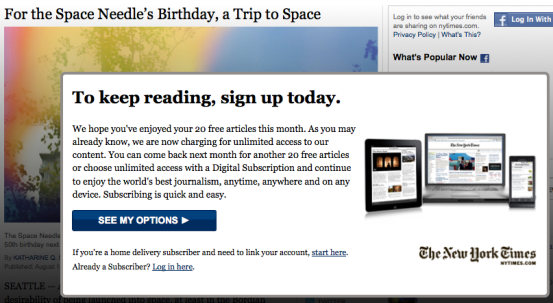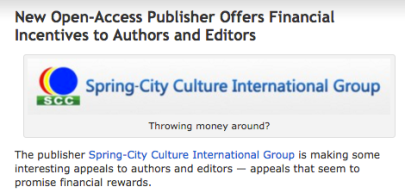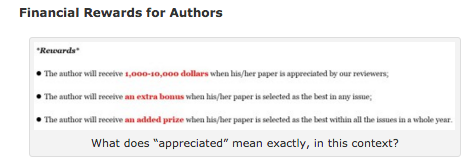As a University student faced with reports, projects and a dissertation, the thought of filtering through heavy research and readings can be a drag. However, an absolute frustration is when we finally found suitable content online, yet come up against a paywall.
Ever felt this way? I would think so. Paywalls are getting increasingly popular and will continue to be on the rise – 90% of online content will be held behind a paywall in the near future (Stephen Lepitak, 2013). This could be the worst nightmare for a student. However, in the perspective of the content producer, is it really that bad to deny Open Access?
With a better understanding of Open Access now, let’s consider what are the pros and cons of open-access to a Content Producer. The below-mentioned points are non-exhaustive, but I have chosen to focus on a few main points.
I created this simple flowchart to explain the advantages of having Open Access.
As seen from the flowchart, open access will enable people to access and build on the content easily. This increases exposure the producer’s works receive and with the growth in appreciation of the content and audience count, recognition and credibility of the work and the producer builds up accordingly.
This advantage is invaluable as it’s not only a form of re-affirmation of the producer’s efforts, it opens new opportunities at the same time. I branched out this second advantage into two sub-groups: Advertising Revenue and Head-hunted. The former allows the producer to work with companies to earn advertising fees when advertisements are placed in popular, well-received sites, between videos etc. The latter is when large corporations identifies the producer’s abilities, hence offer him a career as a content producer for the firm.
The advantages sound alluring, don’t they? Then what is stoping content producers from sharing their content freely?
Disadvantages:
1. Heavy Fees:
When a content producer decides to allow open access to his content, often they themselves have to bear the heavy costs that comes with publishing the content online. However, there are options online that help producers waive this fee and cope with open-access better.
2. Loss of Revenue:
When content is open-access, it means the producer does not earn a single dime thereafter his research is done and is released for free to anyone to use it. This will accumulate to a large amount should the content turn out to be very well-received and is circulated widely.
3. Potential for Fraud:
As we understand the dilemma between earning your keep and doing public good by sharing your research, sometimes, the allure of money can be very tempting. A phenomenon understood as “Research Paper Authoring” has been on the rise as content producers fall to the greed of money, and include other names under the content authorship for a quick buck (Bob Yirka, 2013).
Read more about this thriving black market here.
Of course, having weighed both the pros and cons of having open-access to content producers, is there a way to find a balance?
I personally feel that the reward model Youtube (Cash Rewards for Videos) and Facebook (Facebook Product Share Rewarding) undertakes to reward content producers for viewership/likes/shares can be considered to passively reward these content producers for their effort as reflected by degree of content circulation. Some organisations are stepping up to take on this model, such as Spring City International, so hopefully this could be the Win-Win solution for this situation, in time to come.
Word Count: 500
References:
Bob Yirka, (2013). Investigation Reveals Black Market in China for Research Paper Authoring. Phys.Org. Retrieved from: http://phys.org/news/2013-11-reveals-black-china-paper-authoring.html
Nicole Martin, (2008). Youtube to Give Cash Rewards for Videos. The Telegraph. Retrieved from: http://www.telegraph.co.uk/technology/3356176/YouTube-to-give-cash-rewards-for-videos.html
Sweet Tooth, (2015). Facebook Product Share Rewarding. Retrieved from: http://help.sweettoothrewards.com/article/571-facebook-product-share-rewarding
Quora, (2014). Are Academics Paid for Publication of an Article in a Scientific Journal? Retrieved from: https://www.quora.com/Are-academics-paid-for-publication-of-an-article-in-a-scientific-journal
Wiley, (2014). Understanding Open Access. Retrieved from: https://www.youtube.com/watch?v=o2HMouOV-Lg
Stephen Lepitak, (2013). 90% of Content to be Held Behind Paywalls in Three Years Media Company Survey Suggests. The Drum. Retrieved from: http://www.thedrum.com/news/2013/04/12/90-online-content-be-held-behind-paywalls-three-years-media-company-survey-suggests
Piled Higher and Deeper (PHD Comics), (2012). Open Access Explained! Retrieved from: https://www.youtube.com/watch?feature=player_embedded&v=L5rVH1KGBCY
Wiley, David; Green, Cable; Soares, Louis, (2012). Dramatically Bringing down the Cost of Education with OER: How Open Education Resources Unlock the Door to Free Learning. ERIC. Retrieved from: http://eric.ed.gov/?id=ED535639





Hi Jasmine,
Thanks for giving such a detailed explanation in your blog.
My understanding of the Open Access system had been deepened greatly.
Please forgive me as I have a question for you.
“Ever felt this way? I would think so. Paywalls are getting increasingly popular and will continue to be on the rise – 90% of online content will be held behind a paywall in the near future (Stephen Lepitak, 2013).”
The above is an excerpt from your blog.
This is a worrying matter, isn’t it?
While those in developed countries might have no issues crossing the paywall, it made me think of those in poorer countries such as Iran, Afghanistan, Sierra Leone etc…
Other than the obvious issue of money, they also have a lack of proper infrastructure to support the education system.
Henceforth, I’ll really like to get your opinion on what do you think could be done over in those countries to promote access.
Perhaps for this, let’s assume that hardware and cyber network issues had been resolved.
Edward 😉
LikeLiked by 1 person
Hey there Edward!
Thanks for dropping by my blog!
With regards to your question, yes – it indeed is very worrying! And again, yes – for the cost factor, it will be a great hit for the developing countries, since in developed countries such as our own, even if students had little means of affording these online materials, we can always rely on educational institution’s (eg. SIM in our case) spending to pave the way to these once hidden behind paywalls content.
Cost is just one factor that the developing countries face with regards to accessing online content, as you have mentioned. Infrastructure would be another issue altogether. You mentioned we were discussing under the assumption of hardware and cyber network issues resolved, so I’m a little confused as to what you are insinuating for the infrastructure (or lack of).
However, I feel that what can be done to help with the issue of costs and accessing quality content, would be to adapt to change accordingly.
In areas such as Tehran which is more developed and has the proper hardware to support access to online content, good-will organisations can divert a portion of funds that are periodically donated directed to educational costs, towards subscriptions to a library online materials, instead of spending all on physical books. It can be a gradual change of focus, as we have to bear in mind, the idea of being in a digital era is not yet fully accepted and transitions take time and effort.
Another possibility would be to set up a central centre with subscribed access to online content that is open for the public’s use. This way, funds can be fully maximised and budgets controlled as limited funds are not sprawled all over the nation, with some areas underutilising the access paid for.
While areas that are still heavily conventional, I would suggest to give it time and allow the digital evolution to work its magic before we hastily work on trying get online content access to reach the people there. We have to understand that conventional print would probably still be more suitable for people living in the area, and respond accordingly.
This is really a challenging question, and would require deeper thinking and research to further explore, hence forgive me if I am unable to fully grasp the depth of the question and answer it better!
Thanks again for dropping by! :o) Feel free to share with me your thoughts on my answer!
LikeLiked by 1 person
Jasmine,
Good reply.
My initial comment was on your opinion on how to overcome the problems they face due to the inability to pay for materials. And to ignore the infrastructural problems while answering. But you had answer both quite well and gave me a better understanding. Thank you! 🙂
Edward
LikeLike